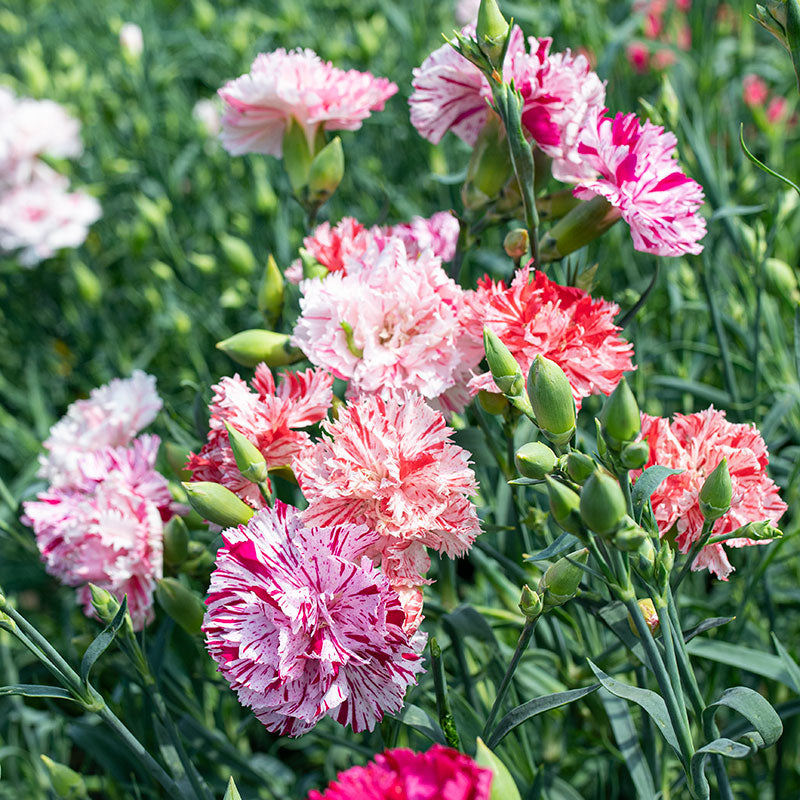When carnations bloom, they bring classic elegance and a splash of vibrant color to gardens and bouquets alike. Their ruffled petals and wide range of hues—from soft pastels to bold reds—have made carnations a beloved flower for centuries. More than just beautiful, carnations symbolize love, fascination, and distinction.
These versatile flowers thrive in well-drained soil with plenty of sunlight. With the right care, carnations reward gardeners with long-lasting blooms that brighten any space.

Portrait of the Carnation
Carnations belong to the Caryophyllaceae family and are primarily represented by Dianthus caryophyllus. They are cherished for their fragrant, fringed petals and long vase life, making them popular in floral arrangements and gardens.
- Type: Perennial (often grown as biennial or annual depending on climate)
- Family: Caryophyllaceae
- Common names: Carnation, Clove pink
Foliage and Form
Carnations produce slender, gray-green leaves that grow along sturdy, upright stems. Their growth habit is bushy but compact, supporting clusters of single or double flowers.
- Height: 30–80 cm (1–2.5 ft)
- Spread: 15–30 cm (6–12 in)
- Growth Habit: Upright, bushy
Blooms and Fragrance
Carnation flowers are notable for their frilled edges and sweet, spicy fragrance reminiscent of clove. Flower colors vary widely, including white, pink, red, yellow, and bi-colors.
- Bloom Time: Late spring through summer
- Color: White, pink, red, yellow, purple, variegated
- Fragrance: Sweet, spicy, clove-like
The Right Time to Plant, Prune, and Enjoy Carnation
| Month | Planting | Flowering | Pruning |
|---|---|---|---|
| January | ❌ | ❌ | ✅ Light pruning (indoor plants) |
| February | ✅ (start seeds indoors) | ❌ | ✅ Pinching to encourage bushiness |
| March | ✅ (transplant outdoors) | ❌ | ✅ Pinching, shaping |
| April | ✅ | ❌ | ✅ Pinching, deadheading |
| May | ❌ | ✅ (start) | ✅ Deadheading |
| June | ❌ | ✅ | ✅ Deadheading |
| July | ❌ | ✅ | ✅ Deadheading |
| August | ❌ | ✅ (late blooms) | ✅ Deadheading, light pruning |
| September | ❌ | ❌ | ✅ Clean-up pruning |
| October | ❌ | ❌ | ✅ Cut back in colder zones |
| November | ❌ | ❌ | ✅ Protect or mulch in cold |
| December | ❌ | ❌ | ❌ |
✅ = Recommended ❌ = Not advised
Watering, Sunlight, and Environment for Carnation
Watering
- Keep soil evenly moist but never waterlogged.
- Water deeply when top inch feels dry.
- Avoid overhead watering to prevent fungal diseases.
Sunlight
- Carnations need full sun (6+ hours daily) to flower profusely.
- Partial shade can reduce bloom quality and quantity.
Indoor vs Outdoor
- Primarily grown outdoors in beds or containers.
- Can be grown indoors with ample light but flowering may be limited.
Temperature
- Prefers mild climates, tolerates cool nights well.
- Ideal range: 10–24°C (50–75°F)
- Hardy to USDA zones 6–9
Ideal Soil Conditions for Growing Carnation
| Soil Feature | Optimal Condition | Why It Matters |
|---|---|---|
| Soil Type | Well-drained, loamy soil | Prevents root rot |
| Texture | Loose, fertile | Supports root development |
| Drainage | Excellent | Avoids soggy roots |
| Moisture | Evenly moist, not wet | Maintains healthy growth |
| Soil pH | Neutral to slightly alkaline (6.7–7.5) | Promotes nutrient availability |
| Fertility | Moderate to high | Supports abundant flowering |
Common Problems & Solutions
| Issue 🐾 | Symptoms 🔍 | Solutions 🛠️ |
|---|---|---|
| Fusarium Wilt 🌿 | Wilting, yellowing leaves | Use resistant varieties, improve drainage |
| Rust Fungus 🍂 | Orange pustules on leaves | Remove infected leaves, fungicides |
| Aphids 🐜 | Sticky residue, curled growth | Spray with insecticidal soap or neem oil |
| Poor Blooming 🌸 | Few flowers, legginess | Pinch tips, ensure full sun, feed regularly |
Carnations blend beauty, fragrance, and longevity. With bright light, balanced moisture, and timely pruning, these classic flowers will flourish and fill your garden with timeless charm.